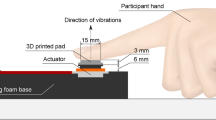Abstract
Communication of natural language via the skin has seen renewed interest with the advent of mobile devices and wearable technology. Efficient evaluation of candidate haptic encoding algorithms remains a significant challenge. We present 4 algorithms along with our methods for evaluation, which are based on discriminability, learnability, and generalizability. Advantageously, mastery of an extensive vocabulary is not required. Haptic displays used 16 or 32 vibrotactile actuators arranged linearly or as a grid on the arm. In Study 1, a two-alternative, forced-choice protocol tested the ability of 10 participants to detect differences in word pairs encoded by 3 acoustic algorithms: Frequency Decomposition (FD), Dominant Spectral Peaks (DSP), and Autoencoder (AE). Detection specificity was not different among the algorithms, but sensitivity was significantly worse with AE than with FD or DSP. Study 2 compared the performance of 16 participants randomized to DSP vs a phoneme-based algorithm (PH) using a custom video game for training and testing. The PH group performed significantly better at all test stages, and showed better recognition and retention of words along with evidence of generalizability to new words.
Access this chapter
Tax calculation will be finalised at checkout
Purchases are for personal use only
Similar content being viewed by others
References
Reed, C.M., Rabinowitz, W.M., Durlach, N.I., Braida, L.D., Conway-Fithian, S., Schultz, M.C.: Research on the Tadoma method of speech communication. J. Acoust. Soc. Am. 77, 247–257 (1985). https://doi.org/10.1121/1.392266
Brooks, P.L., Frost, B.J., Mason, J.L., Gibson, D.M.: Continuing evaluation of the Queen’s University tactile vocoder II: identification of open set sentences and tracking narrative. J. Rehabil. Res. Dev. 23, 129–138 (1986)
Israr, A., Meckl, P.H., Reed, C.M., Tan, H.Z.: Controller design and consonantal contrast coding using a multi-finger tactual display. J. Acoust. Soc. Am. 125, 3925–3935 (2009). https://doi.org/10.1121/1.3124771
Galvin, K.L., Mavrias, G., Moore, A., Cowan, R.S.C., Blamey, P.J., Clark, G.M.: A comparison of Tactaid II+ and Tactaid 7 use by adults with a profound hearing impairment. Ear Hear. 20, 471–482 (1999). https://doi.org/10.1097/00003446-199912000-00003
Oller, D.K.: Tactile AIDS for the hearing impaired: an overview. Semin. Hear. 16, 289–295 (1995). https://doi.org/10.1055/s-0028-1083726
Miyamoto, R.T., Robbins, A.M., Osberger, M.J., Todd, S.L., Riley, A.I., Kirk, K.I.: Comparison of multichannel tactile AIDS and multichannel cochlear implants in children with profound hearing impairments. Am. J. Otol. 16, 8–13 (1995). https://doi.org/10.1016/0165-5876(95)97416-6
Brooks, P.L., Frost, B.J.: Evaluation of a tactile vocoder for word recognition. J. Acoust. Soc. Am. 74, 34–39 (1983). https://doi.org/10.1121/1.389685
Muda, L., Begam, M., Elamvazuthi, I.: Voice recognition algorithms using mel frequency cepstral coefficient (MFCC) and dynamic time warping (DTW). Techniques 2, 138–143 (2010). https://doi.org/10.5815/ijigsp.2016.09.03
Hinton, G.E., Salakhutdinov, R.R.: Reducing the dimensionality of data with neural networks. Science 313, 504–507 (2006). https://doi.org/10.1126/science.1127647
Zhao, S., Israr, A., Lau, F., Abnousi, F.: Coding tactile symbols for phonemic communication. In: Proceedings of CHI 2018 (2018). https://doi.org/10.1145/3173574.3173966
Israr, A., Poupyrev, I.: Tactile brush: drawing on skin with a tactile grid display. In: Proceedings of CHI 2011, pp. 2019–2028 (2011). https://doi.org/10.1145/1978942.1979235
Pesarin, F., Salmaso, L.: The permutation testing approach: a review. Statistica 70, 481–509 (2010). https://doi.org/10.6092/issn.1973-2201/3599
Lim, S.J., Holt, L.L.: Learning foreign sounds in an alien world: videogame training improves non-native speech categorization. Cogn. Sci. 35, 1390–1405 (2011). https://doi.org/10.1111/j.1551-6709.2011.01192.x
Przybylski, A.K., Rigby, C.S., Ryan, R.M.: A motivational model of video game engagement. Rev. Gen. Psychol. 14, 154–166 (2010). https://doi.org/10.1037/a0019440
Hewlett, D., Cohen, P.: Word segmentation as general chunking. In: Proceedings of Fifteenth Conference on Computational Natural Language Learning, pp. 39–47 (2011)
MacMillan, N.A.: Signal detection theory. In: Stevens’ Handbook of Experimental Psychology (2002)
Acknowledgements
This work was supported by Facebook, Inc.
Author information
Authors and Affiliations
Corresponding author
Editor information
Editors and Affiliations
Rights and permissions
Copyright information
© 2018 Springer International Publishing AG, part of Springer Nature
About this paper
Cite this paper
Turcott, R. et al. (2018). Efficient Evaluation of Coding Strategies for Transcutaneous Language Communication. In: Prattichizzo, D., Shinoda, H., Tan, H., Ruffaldi, E., Frisoli, A. (eds) Haptics: Science, Technology, and Applications. EuroHaptics 2018. Lecture Notes in Computer Science(), vol 10894. Springer, Cham. https://doi.org/10.1007/978-3-319-93399-3_51
Download citation
DOI: https://doi.org/10.1007/978-3-319-93399-3_51
Published:
Publisher Name: Springer, Cham
Print ISBN: 978-3-319-93398-6
Online ISBN: 978-3-319-93399-3
eBook Packages: Computer ScienceComputer Science (R0)




